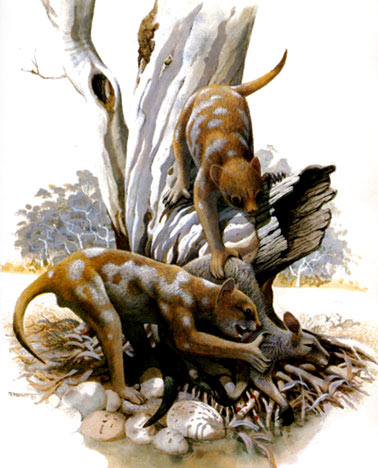
|
Search JoyZine with Google Site Search! |
Marsupial Lion Thylacoleo carnifex
The marsupial lion, one the greatest carnivores to roam Australia, had the most powerful bite of any mammal species—living or extinct. This assessment comes from scientists who have compared the heads of all manner of beasts, from dogs to bears. None had the ability to bite down on its prey with quite the same force, say Dr Stephen Wroe and colleagues. The lion, so described because of its cat-like appearance, became extinct more than 40,000 years ago. Fossil evidence shows it must have been a remarkable predator. Its stocky teeth, although not quite on the same scale as those of sabre-toothed cats, would have inflicted terrible flesh wounds. The lion also had a huge "thumb claw" to grapple with and disembowel its victims. "Thylacoleo carnifex was one of the meanest, most frightening animals you could have the misfortune to meet," Dr Wroe, from the University of Sydney, told the BBC. Competitive edge Wroe's team studied the skulls of 39 mammalian carnivores, eight of them now known only from the fossil record. The work estimates the closing force at the canine-end of the animals' jaws; a simple model constructed by the researchers allows them to compare the relative biting power of all the creatures, irrespective of their size. The data shows—as one might expect—that the carnivores with the biggest bite forces are typically the ones that take larger prey, relative to themselves. It seems intuitive that to be able to win out in such a confrontation, a competitive edge is needed. But then the data starts to throw up some surprises—not least between marsupials and placentals. "Marsupials for any given size had a much bigger bite than placentals," explained Dr Wroe. "A 30kg Tasmanian tiger was biting much harder than a 30kg grey wolf. The marsupial lion, which on average was about 100kg, had a bite force comparable to that of a 250kg African lion. Rapid bleed The researchers have an idea why this might be, and it goes to brain size and possibly to intelligence. Modern placentals have bigger brains than their more primitive forebears, including marsupials. It seems conceivable, Wroe and colleagues believe, that the skull architecture required for these bigger brains has evolved at the expense of muscle potential. But what the placentals lack in terms of pure biting power they compensate for in their smarter attack strategies—and the more precise manner in which they seek to kill their prey. "The cross-sectional area available for the two major muscle jaw-closing systems may be inversely proportional to the size of the brain. Perhaps modern placentals can do the same job by being more precise," said Dr Wroe. And this hypothesis takes an interesting turn with sabre-toothed cats. The data shows them to have had relatively small bites for their size. Modern lions or tigers today have similar bite forces and are substantially smaller animals. But who needs to bite hard when your giant, 15cm-long canines will punch deep into a victim's neck and bring about rapid bleeding and death? New questions Professor Norman MacLeod, keeper of palaeontology at the 's Natural History Museum, commented that this type of study enabled scientists to open up new research questions about extinct (and living) creatures. "Scaling relationships, for example, are used to estimate maximum travelling speeds of ancient animals based on the size of their feet and the length of their stride," he explained. "Researchers will look for deviations in trends. When an animal deviates strongly raises valid research questions about the design of that animal. For example, if you plot brain size versus body size, there is a nice, regular relationship—but in humans, we are way off the scale. "That's because there's been much greater brain development in humans than in any other animal." |
